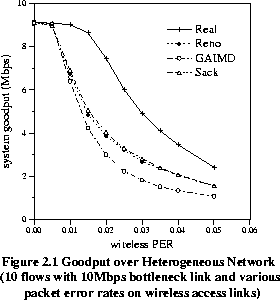
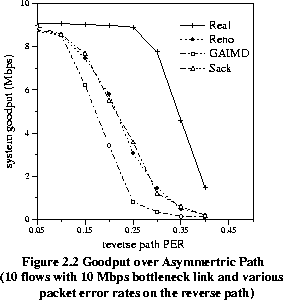
Receiver-oriented and
Measurement-based Transmission Control
in Heterogeneous (Wired/Wireless)
Networks
Chi Zhang, School of Computer Science, Florida International University
Vassilis Tsaoussidis, Dept. of Electrical
& Computer Engineering, Demokritos University, Greece
Therefore, our research on congestion control for the next-generation transport protocols advances mainly on two fronts: the application requirements (e.g. quality of service) and the characteristics of the underlying networks (e.g. wireless links). Our recent research efforts are summarized as follows:
1. The Interrelation
of Smoothness and Responsiveness in Heterogeneous and Dynamic
Environments
A new family of protocols, namely the TCP-friendly protocols, are designed with two competing objectives: (i) to achieve smooth transmission adjustments for real-time applications, which is accomplished by reducing the window decreasing factor during congestion, and (ii) to compete fairly with TCP flows, which is accomplished by moderating the window increasing rate based a TCP throughput equation [3]. We were particularly interested in a parameterized TCP-friendly protocol, GAIMD [6], which generalizes TCP by parameterizing the congestion window increase value α and decrease ratio β.
In [8, 10, 12],we investigated the interrelation of TCP smoothness and responsiveness by studying the combined dynamics of friendliness-oriented α/β tradeoff and the network conditions for achieving efficiency and smoothness. We categorized three classes of TCP-friendly TCP(α, β) protocols: (i) Standard TCP, that is TCP(1, ½); (ii) Responsive TCP with relatively low β and high α (iii) Smooth TCP with relatively high β and low α. We confirmed experimentally that, in general, smoothness and responsiveness constitute a tradeoff; however, we uncover undesirable dynamics of the protocols when the network is heterogeneous (wired/wireless) or the flow characteristics do not follow a prescribed and static behavior:
Furthermore, we realized that the ultimate reasons behind the above phenomena and observations are some inherent characteristics of equation-based TCP-friendly protocols:
We concluded that equation-based adjustments could guarantee neither efficiency nor friendliness on its own, in the context of heterogeneous networks and dynamic environments. A supportive mechanism for error classification and bandwidth detection may complement the equation-based adjustments and produce positive dynamics.
2. TCP-Real:
Receiver-oriented and Measurement-based Congestion
Control
We have developed TCP-Real [5, 7, 9], which employs a receiver-oriented and measurement-based congestion control mechanism that significantly improves TCP performance for both delay-sensitive and delay-tolerant applications in heterogeneous (wired/wireless) networks and over asymmetric paths (see Figures 2.1 and 2.2). TCP-Real relies on three novel congestion detection mechanisms beyond packet loss detection:


3. TCP(α, β, γ, δ): Improving TCP
Smoothness by Synchronized and Measurement-based Congestion
Avoidance
The challenge of improving TCP smoothness for real-time applications does not lie in simply achieving smooth window adjustments, but rather in providing smoothness along with bandwidth efficiency, fairness, responsiveness, as well as controlled queue length.
We observed in [11] that although multiplicative decrease is necessary to accomplish fairness in congestion control, it does not inevitably sacrifice system throughput, as long as the system operates between the knee and the cliff, according to an equation. However, even when the system throughput is relatively stable, end users of real-time applications do not necessarily experience smooth performances (see Figure 3.2). We emphasized that in a real system multiplicative window decreases are often unsynchronized among competing TCP flows, due to random congestive drops. We further argued that the major obstacle for achieving smoothness is the unsynchronized and random window control, and analyzed its negative impact on smoothness, short-term fairness, and even long-term fairness measured by a worst-case fairness index.
We therefore proposed an experimental congestion avoidance mechanism [11] to improve TCP smoothness for real-time applications. The mechanism relies on a fine-grained RTT estimation to measure the network condition, and coordinates the upward and downward window adjustments to abolish the damage of unsynchronized window control. Congestive packet drops are reduced by a new control parameter γ, which determines the window decreasing ratio when the level of contention exceeds a threshold that indicates an upcoming congestion. The bottleneck queue length can also be controlled in an end-to-end fashion. Simulation results confirm that the new mechanism enhances significantly the smoothness and fairness (see Figures 3.1, 3.2 and 3.3), without a cost of responsiveness. In fact, by enabling a new parameter δ, the responsiveness can be even enhanced adaptively when the bandwidth is under-utilized.
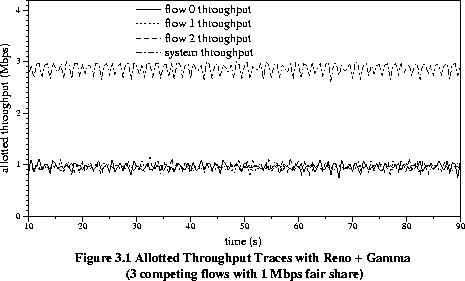
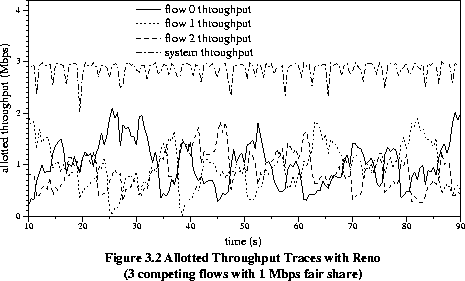
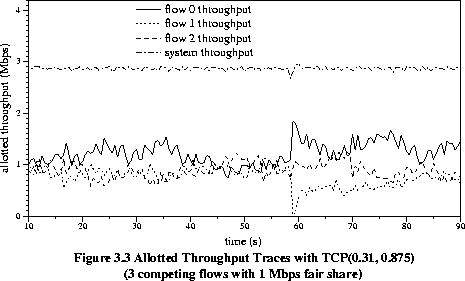
References
1. M. Allman, V. Paxson and W. Stevens, "TCP Congestion
Control", RFC2581, April 1999.
2. D.-M. Chiu and R. Jain, "Analysis of the Increase and Decrease Algorithms
for Congestion Avoidance in Computer Networks", Computer Networks and ISDN
Systems, 17(1):1-14, June 1989.
3. J. Padhye, V. Firoiu, D. Towsley, and J.
Kurose, "Modeling TCP Throughput: A Simple Model and its Empirical Validation",
In Proceedings of ACM SIGCOMM '98, August 1998.
4. V. Tsaoussidis, A. Lahanas and
C. Zhang , "The
Wave & Probe Communication Mechanisms", Journal of Supercomputing (Kluwer),
20(2):115-135, September 2001. PDF
5. V. Tsaoussidis and C.
Zhang , "TCP-Real: Receiver-Oriented Congestion Control", Journal of Computer
Networks (Elsevier), Vol. 40, No. 4, November 2002. PDF
6. Y.R. Yang and S.S. Lam,
"General AIMD Congestion Control", In Proceedings of the 8th International
Conference on Network Protocols, November 2000.
7. C. Zhang
and V. Tsaoussidis
, "Exploiting the Potential of TCP-Real in Multiplexed
Wired/Wireless Channels", The 1st International Workshop
on Wired/Wireless Internet Communications (WWIC 2002), June 2002.
8. C. Zhang and V.
Tasoussidis , "On the Efficiency of TCP-friendly
Window Adjustment Strategies in Wired/Wireless Networks" (invited paper), Conference
on Scalability and Traffic Control in IP Networks, SPIE ITCOM 2002, July
2002.
9. C. Zhang and V.
Tsaoussidis , "TCP-Real Improving Real-time Capabilities of
TCP over Heterogeneous Networks", The 11th International Workshop on
Network and Operating Systems Support for Digital Audio and Video
(ACM NOSSDAV 2001), June 2001. PDF
10. C. Zhang and V.
Tsaoussidis, "The Interrelation of TCP Smoothness and
Responsiveness in Heterogeneous Networks", The 7th IEEE
Symposium on Computers and Communications (ISCC 2002), July 2002.
(Runner-up award winner)
PDF
11. C. Zhang and V.
Tsaoussdis, "Improving TCP Smoothness by Synchronized and Measurement-based
Congestion Avoidance", The
13th International Workshop on Network and Operating Systems Support
for Digital Audio and Video (ACM NOSSDAV 2003), June 2003. PDF
12. V. Tsaoussidis and C. Zhang, "The Dynamics of Responsiveness and
Smoothness in Heterogeneous Networks", IEEE Journal on Selected Areas in Communications, March 2005.